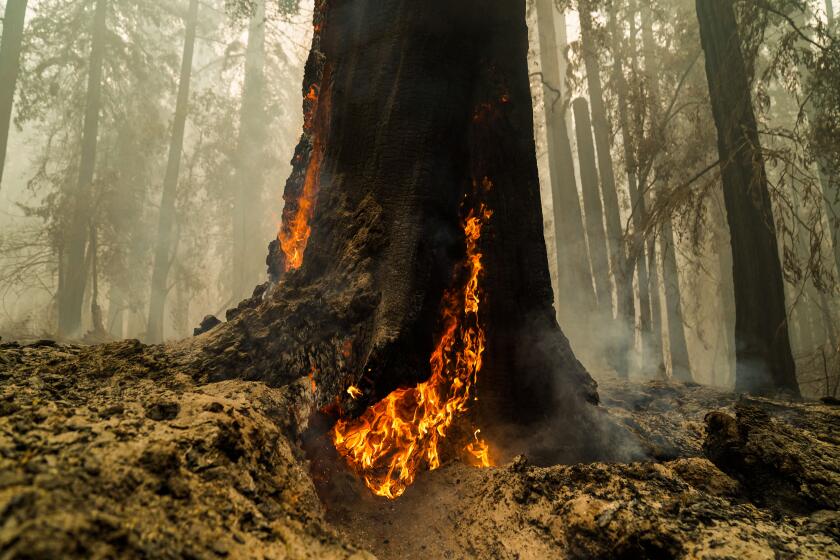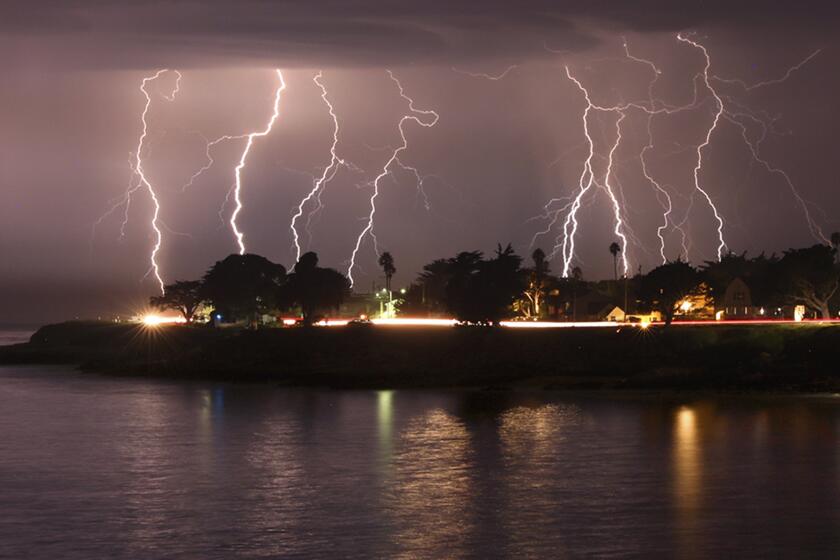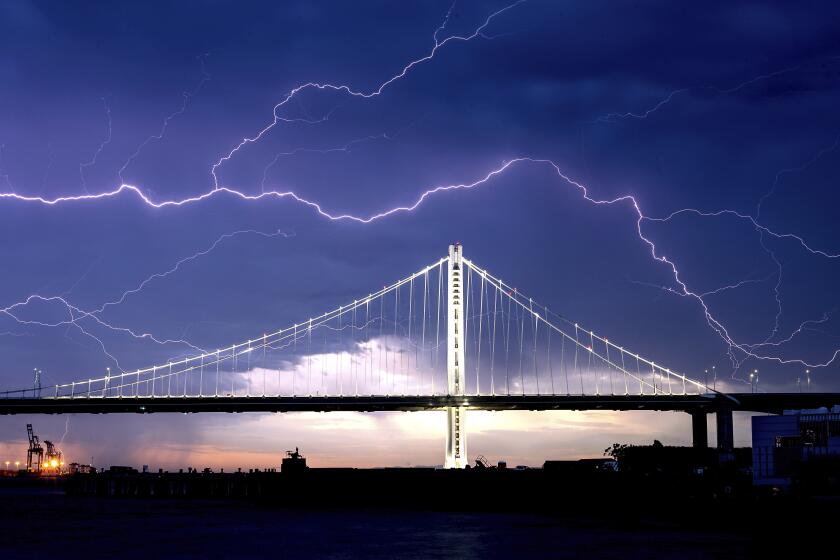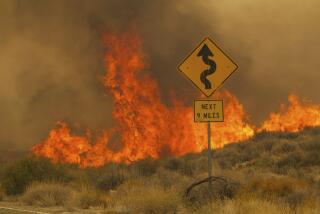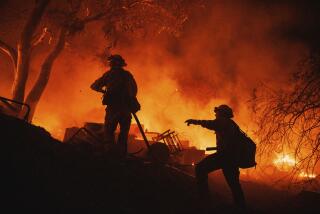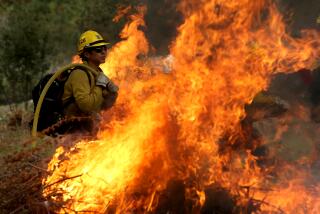California is primed for a severe fire season, but just how bad is anybody’s guess
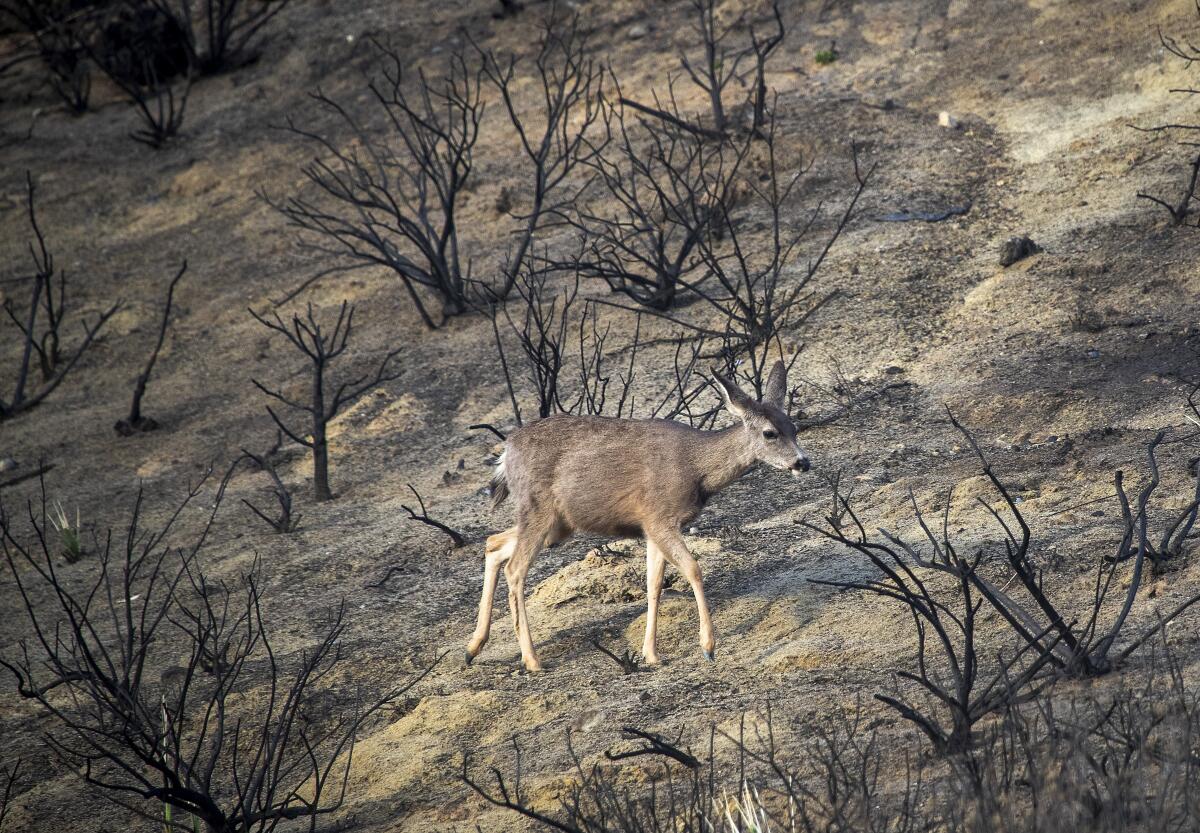
At this point, it seems like almost a given that California will see another historic fire season.
A meager rainy season is in the rearview mirror. Snowpack is depleted. Vegetation and soils are parched.
“All the indications are that we are heading into another really bad fire year,” said Safeeq Khan, assistant cooperative extension specialist of water and watershed sciences at the University of California Division of Agriculture and Natural Resources.
But there are still some key variables that haven’t yet taken shape. Weather events, human behavior and even luck will dictate whether 2021 goes down in the record books like 2020, when California wildfires burned an area larger than the state of Connecticut.
“We like to cite the Swiss cheese model,” said Nick Nauslar, fire meteorologist at the National Interagency Fire Center in Boise, Idaho. “You have to have enough holes in the cheese line up for us to get a season like we did last year.”
California has entered another drought. But depending on who you ask, the last one may have never really ended.
Dryness typically predicts a very active summer fire season in Western U.S. forests, said Park Williams, bioclimatologist and professor at UCLA.
“But in order to have fire you need more than just drought. You also need fuel to burn,” he said. “And so in grassland areas, the fire season might not actually be so bad because there’s not a lot of whole new grass to burn.”
Counterintuitively, an extremely dry year can actually mean Southern California will see fewer fires, as flames often spread from a human source into nearby shrublands or forests, said James Randerson, professor of earth system science at UC Irvine.
“If you think of a road and a car with a muffler that’s dragging, if it’s a year with a lot of moisture, then the fine fuels and all the grasses along the roads will be connected more to that chaparral area nearby,” he said.
“It’s my sense — and it’s supported by our analysis of some of the data from Cal Fire — that there’s a lower risk for having a large number of fires when you have a drought like this, because it’s cutting into the connectivity of the fine fuels and the herbaceous fuels, all the grasses.”
But Randerson’s research with Yufang Jin of UC Davis has also indicated that once fires do start under these conditions, they tend to grow larger and escape human control more quickly.
“When there’s drought there may be fewer fires, but when they do ignite they tend to move faster, can get bigger and be more destructive,” Randerson said. “The fuel is drier so they move more rapidly out of containment.”
The number of hot days is also key, he said.
“If we have a few really intense heat waves into August and early September, that’s an important threat,” Randerson said. “Those factors are equally important, if not more important, for structuring the fire year as the drought conditions in the preceding winter.”
California appears to be heading into an active fire season, but there are some key variables that haven’t yet taken shape.
Weather models suggest the West will be dry through June, and temperatures are likely to be above normal, said Heath Hockenberry, fire weather program manager for the National Weather Service.
“The fact that it is drier is overall the worst case scenario,” Hockenberry said. “I don’t want to characterize this season as the worst case scenario but the worst case scenario is when you have long-term drying, no rain and you throw lightning on top of that.”
Those variables aligned last summer during the state’s hottest August on record and turned what was expected to be a pretty bad fire year into an unprecedented one.
“Last year, the forests were pretty dry during this point in the year,” Williams said. “I would have told you fire season might be kind of bad. But as it turned out the fire season ended up being extraordinary.”
First came the record-breaking temperatures, with parts of Los Angeles County soaring well above 100 degrees. Then a tropical storm sent a huge amount of moisture up the coast from Mexico, running headlong into the heat wave.
“Hot air tends to rise, and when that hot air is humid, you get intense lightning storms,” Williams said.
The dry lightning strikes sparked hundreds of fires that tore through sunbaked brush and merged into giant infernos. That was followed weeks later by another historic heat wave and fierce downslope winds.
Of the six largest wildfires ever recorded in California, four were ignited by these lightning storms, including the largest — the August Complex fire spanning across five counties — as well as the third-, fifth- and sixth-largest. By the end of the 2020 season, nearly 4.4 million acres had burned across the state, exceeding the previous record of nearly 2 million acres set in 2018.
The lightning storms and heat waves were impossible to forecast at this time last year, Williams said.
“They were truly extraordinary events,” he said. “And of course global warming promotes the odds of those heat waves occurring but nonetheless, an event of that magnitude would have been unthinkable if you had asked me in April whether or not one was going to occur that summer.”
Although the scope of last year’s storms was unusual, lightning itself is not uncommon during California summers. Lightning can result from the North American monsoon, which develops in late June as moist air from Mexico moves toward Arizona and New Mexico in July, or from tropical storms that travel up the coast in late summer to early fall, Hockenberry said.
“So we are expecting lightning events,” he said. “But what we can’t predict is exactly where they’re going to be and how widespread.”
Many of California’s largest wildfires have been started by dry lightning strikes
Climate change could make the phenomenon an even more routine occurrence, Randerson said.
“There’s evidence the atmosphere will become hotter at the surface and less stable and that will generate more thunderstorms, which will generate more lightning,” he said.
Shifts in climate and human activity are priming California’s landscape for more severe fire seasons in other ways.
When drought-stressed trees die or are left vulnerable to fatal insect infestations, the dead fuel accumulates in forests and becomes combustible, resulting in fires that burn hotter and spread more quickly.
That could be seen during last year’s Creek fire, which ignited in the Sierra National Forest, where bark beetle attacks have killed nearly 150 million trees during the last decade. The wildfire rapidly grew into the state’s fourth-largest on record. The U.S. Forest Service estimated upward of 80% of its fuel source was beetle-killed timber, with the dead stands containing an estimated 2,000 tons of fuel per acre.
At the same time, rising temperatures are causing more precipitation to fall as rain, instead of snow, which retards fire. The snow that does fall also melts earlier in the year, Khan said.
“So you have a lot more things waiting to ignite and burn,” he said.
As one of the worst heat waves in years continues to broil California, millions are experiencing the havoc that ensues with the type of extreme weather that is growing more frequent with climate change.
Researchers at UC Irvine recently found the state’s burn season has grown longer over the last 20 years, with the start advancing from June to May and the peak shifting from August to July.
Their study, published Thursday in the Nature Scientific Reports journal, also found that the number of communities facing severe fire risk has grown significantly in recent years due to both hotter, drier conditions and an uptick in humans living in previously unpopulated wildland areas.
“The concurrence of human-caused climate change, which is drying out our forests and grasslands and creating longer stretches of hot weather, and a steady influx of people into remote areas is creating conditions for the perfect fire storm,” said co-author Tirtha Banerjee, assistant professor of civil and environmental engineering at UC Irvine, in a statement.
The National Interagency Fire Center’s Predictive Services has advised fire managers that California’s mountains and foothills are likely to see “an above normal significant fire potential” starting in July and maybe even earlier, in June, said Nauslar, who helped write the unit’s seasonal fire outlook.
The region could get a bit of a reprieve from a storm system forecast to bring rain and mountain snow over the weekend and Monday, he said.
“But given the dwindling snowpack and how dry it’s been through this winter and even dating back to last year, it’s really only going to delay things and not solve any of the systemic issues that we see with the fuels,” Nauslar said.
In fact, in some areas, the rain is likely to feed the growth of grasses and other fine fuels that will dry out by the end of summer and could contribute to larger fires, he said.
“Once June and July come about, with little in the way of precipitation, we’re going to have to be prepared for fires to begin earlier, through the entire summer,” Hockenberry said. “It just basically depends on lightning and things that we can’t control, which is arson and human activity as well. That is something that is completely unpredictable.”
More to Read
Start your day right
Sign up for Essential California for news, features and recommendations from the L.A. Times and beyond in your inbox six days a week.
You may occasionally receive promotional content from the Los Angeles Times.

